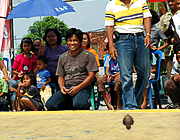
 INDIGENOUS FORMS OF PLAY
INDIGENOUS FORMS OF PLAY
Traditional games are a very significant part of Southeast Asia’s cultural heritage. Whether they involve adults or children, the indigenous forms of play reflect the in genuity and resourcefulness of their forefathers in creat ing their own games by using inexpensive materials for their pastimes and recreation.
Though simple, most of these games have significant cult ural and social value. They encourage children to exer cise their creativity and in doing so fosters development of their social skills, especially strengthening team spirit in schools and within neighbourhoods.
For East Coast Malays, especially those residing in the States of Melaka, Tereng ganu and Kelantan in Malaysia, one such popular game is top spinning or ‘Gasing’ – a particular term used interchangeably to describe either the game itself (spelled using the uppercase) or the spinning top (spelled using the lower case) which is about the size of a dinner plate. Spinning it requires a high level of dexterity and precise timing.
Basically, there are two classes of ‘gasing’. One is ornamental – strictly for display purposes and the other are used for playing. Both adults and children play the game but bigger or what is called ‘giant top spinning’ is more a game for adults. These types of tops can spin for a much longer period of time.
In Malaysia, there are five different shapes of ‘gasing’, namely: plate-shaped, heart-shaped, hat top, egg-shaped and the Berembang-shaped top which resem bles the fruit of a seaside-growing tree.
Normally, the flatter and heavier top designs add much in determining how long a top spins for any length of time because when spun correctly and as the internal weight of the top rotates it produces the overall circular motion that revolves around its auger, or in this case, its cylindrical, non-helical pointed stick blade or nail.
 THE GYROSCOPIC EFFECT
THE GYROSCOPIC EFFECT
For competition purposes that are usually held during informal contests, tournaments and festi vals throughout the year, design and quality of a gasing counts most. The action of a top relies on the gyroscopic effect for its operation. Typically the top will at first wobble until the shape of the tip and its interaction with the surface force it up right. After aligning itself upright for an extended period, the angular momentum, and therefore, the ‘gyroscopic effect’ will gradually lessen, leading to ever increasing precession (or change in the orien tation of the rotation axis of a rotating body), finally causing the top to topple in a frequently violent last thrash.
 In Malaysia, the making of a good top begins with the selection a fine piece of hard wood and only the base and upper roots (or the portion where a branch joins the trunk) are acceptable. The wood takes a few weeks to dry naturally. Only then is it shaped into a discus.
In Malaysia, the making of a good top begins with the selection a fine piece of hard wood and only the base and upper roots (or the portion where a branch joins the trunk) are acceptable. The wood takes a few weeks to dry naturally. Only then is it shaped into a discus.
For metal tops, the edge has to be accurately grooved in order to have a good grip of the metal rim. A good metal gasing requires perfect sym metry – an important attribute to longer spinning time. From start to finish, a good giant metallic top might need four to six weeks to complete in the hands of an expert gasing craftsman.
NO CHILD’S PLAY
Giant top spinning in Malaysia is no child’s play. That’s because each gasing weighs approximately 5- kg. It calls for strength, coordination and skill. In the hands of an expert top-spinner, a perfectly balanced gasing can spin continuous ly for as long as two hours at a stretch.
Watch The Video
 KEEP THE TOP SPINING
KEEP THE TOP SPINING
The game of Gasing is performed often after work ing hours and when there is still light shimmering outside. A group of players gather at an open place, usually in parks or community grounds. Soon, other aficionados (or enthusiasts) of the game, onlookers and curiosity-seekers start trick ling in.
Each player must be highly-skilled and well-versed in many rules of the game and this often varies according to the type of gasing used. The number of participants is usually not fixed. Gasing can be played in teams or individually, but the aim of the game is to keep the top spinning for as long as possible within a specified area or arena.
In individual play, a circle is drawn depicting the area in which the top must spin. A string is tightly wound clockwise round the base of the top, beginning from the nail. The player clasps the top in his hand, gripping the loose end of the string between the fingers. He then throws the top into the circle and swings the string backwards to give the top its spinning effect. As soon as the top hits the ground, a time-keeper marks time on a clock but if the top spins out of the circle, the player loses the game. The player whose top out spins the rest wins the game.
In team play, on the other hand, circles are drawn for each team. Players from each team spin their tops into the respective circles at the same time. When the top stops or spins out of the circle, the next member of the team quickly throws in his top. The team whose last top out spins the rest wins the game. This type of play resembles a relay race in reverse, that is, where the winner is not the running team member who finishes first.
 Both forms described above are what are called ‘Gasing Uri’ or spinning contests to determine who can spin a top for the longest time. In one vari ation, after a gasing is launched, it is quickly but carefully scooped off the ground with a narrow thin wooden bat and there it is left to spin for as long as possible. The trick of this delicate maneu ver is to ensure that the top doesn’t topple over during the transit.
Both forms described above are what are called ‘Gasing Uri’ or spinning contests to determine who can spin a top for the longest time. In one vari ation, after a gasing is launched, it is quickly but carefully scooped off the ground with a narrow thin wooden bat and there it is left to spin for as long as possible. The trick of this delicate maneu ver is to ensure that the top doesn’t topple over during the transit.
Sparring or ‘striking’ matches, on the other hand, are by some considered far more exciting and don’t require audiences to stand and watch an expertly spun top spin on and on for hours. As the name suggests, each contestant must try to ‘strike’ their opponent’s tops off-bounds so that the already spinning tops topple over losing their balance, momentum and speed. In Malaysia, this form of top spinning competition is called ‘Gasing Pangkah’.
Gasing is a game that is also played in neighbouring Southeast Asian countries like Brunei, Singapore, the Philippines (where it is called ‘turumpo’ or ‘trumpo’ after the Spanish word ‘trompo’ for top), and some parts of southern Thailand, where there are large concentrations of Malay communities.



 The national flag of the Federation of Malaysia, also known as the Jalur Gemi lang (Malay for "Stripes of Glory"), was first raised on September 16, 1963. It has 14-equal horizontal stripes of red (top) alternating with white (bottom); there is a blue rectangle in the upper hoist-side corner bearing a yellow cres cent and a yellow 14-pointed star. The 14-stripes stand for the equal status in the federation of the 13-member states and the federal government. The 14-points on the star represent the unity between these entities. The crescent is a traditional symbol of Islam. Blue sym bolizes the unity of the Malay people and yellow is the royal colour of Malay rulers.
The national flag of the Federation of Malaysia, also known as the Jalur Gemi lang (Malay for "Stripes of Glory"), was first raised on September 16, 1963. It has 14-equal horizontal stripes of red (top) alternating with white (bottom); there is a blue rectangle in the upper hoist-side corner bearing a yellow cres cent and a yellow 14-pointed star. The 14-stripes stand for the equal status in the federation of the 13-member states and the federal government. The 14-points on the star represent the unity between these entities. The crescent is a traditional symbol of Islam. Blue sym bolizes the unity of the Malay people and yellow is the royal colour of Malay rulers.